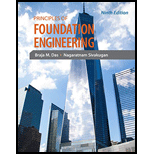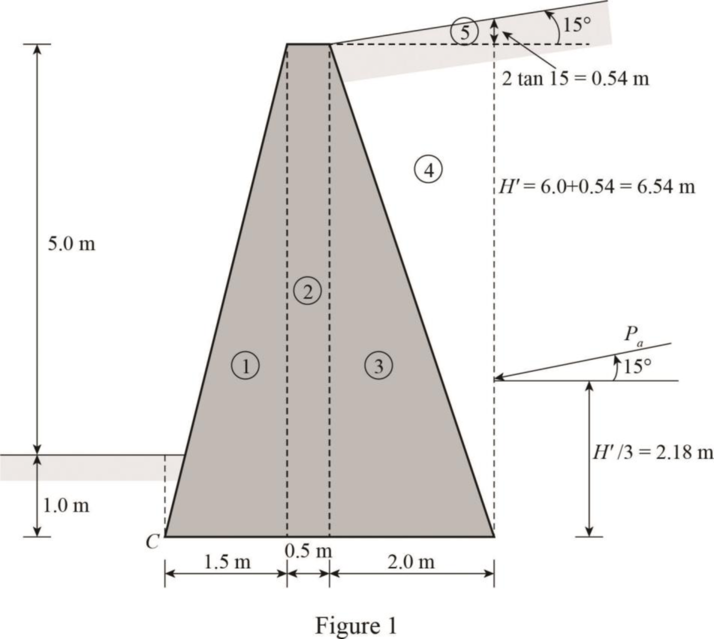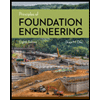
Find the factor of safety against overturning, sliding, and bearing capacity.
Answer to Problem 17.1P
The factor of safety against overturning is
The factor of safety against sliding is
The factor of safety against bearing capacity failure is
Explanation of Solution
Given information:
The frictional angle of backfill
Unit weight of backfill
The backfill makes an angle of
Unit weight of concrete is
Calculation:
Calculate the weight and moment arms by dividing the retaining wall and soil regions interest into rectangles and triangles.
Show the rectangles and triangles divided in the structure as in Figure 1.

Refer Table 16.3, “Values of
The value of active earth pressure
From Figure 1.
The total height from base is
Find the total force per unit length of the wall
Substitute
Find the horizontal force
Substitute
Find the vertical force
Substitute
Find the weight and moment about C for the sections as in Table 1.
| Section |
Weight |
Moment arm from C (m) |
Moment about C |
| 1 | 1 | 108 | |
| 2 | 1.75 | 126 | |
| 3 | 2.67 | 384.5 | |
| 4 | 3.33 | 369.6 | |
| 5 | 3.33 | 33.3 | |
| 4 | 121.6 | ||
Analyze the stability with respect to overturning:
Find the overturning moment
Substitute
From Table 1, the value of resisting moment is
Find the factor of safety against overturning using the relation:
Substitute
Therefore, the factor of safety against overturning is
Find the passive earth pressure coefficient
Substitute
Find the passive force
Here, D is the depth of retaining wall below the soil.
Substitute
Find the value of
Substitute
Find the factor of safety against sliding using the relation:
Substitute
Therefore, the factor of safety against sliding is
Analyze the stability with respect to bearing capacity failure:
Find the eccentricity (e) of the resulting force using the relation:
Here, B is the base width of the retaining wall.
Substitute 4 m for B,
The value of
The calculated eccentricity value is less than the value of
Find the maximum value of pressure at
Substitute
Find the ultimate bearing capacity
Find the value of
Substitute
Find the value of
Substitute 4 m for B and 0.116 m for e.
Refer Table 6.2, “Bearing capacity factors” in the textbook.
The value of
Find the depth factor
Substitute
For
Find the inclination of load on the foundation with respect to vertical
Substitute
Find the inclination factor
Substitute
Find the inclination factor
Substitute
Substitute
Find the factor of safety against bearing capacity failure using the relation:
Substitute
Therefore, the factor of safety against bearing capacity failure is
Want to see more full solutions like this?
Chapter 17 Solutions
Principles of Foundation Engineering (MindTap Course List)
- 3. An infinite slope has shear strength parameters at the interface: c = 30 kPa, φ = 30°, γ = 17 kN/m3 (Assume 1 m strip perpendicular to the paper and 1 m strip along the inclination of the infinite slope). a. If H = 5 m, and β = 20°, find the sliding force. b. If H = 5 m, and β = 20°, find the force that resist sliding on the rock surface. c. If HCR = 8 m, find the minimum angle β so that the slope is stable.arrow_forwardA retaining wall has a vertical back and is 7.32 m high. The soil is sandy loam of unit weight 17.30 KN/cum, it shows a cohesion of 12KPa and angle of friction 20 degrees. Neglecting the wall friction, determine the thrust on the wall in KN/m. The upper surface of the fill is horizontal. 121 343 232 104arrow_forwardA retaining wall 9 m high supports a cohesionless sandy soil with its face vertical as shown in figure below. Find active earth pressure on the wall , Take Yw = 9.81kN / (m ^ 3)arrow_forward
- It is required to design a cantilever retaining wall to retain a 5.0 m high sandy backfill. The dimensions of the cantilever wall are shown in Figure 15.52 along with the soil properties. Check the stability with respect to sliding and overturning, based on the active earth pressures determined, usinga. Coulomb's earth pressure theory (δ' = 24°), andb. Rankine's earth pressure theory.The unit weight of concrete is 24 .0 kN/m3arrow_forwardA retaining wall 6 m high supports cohesionless soil having a dry density of 1600 kg/m³, angle of resistance 32 and void ratio of 0.68. The surface of the soil is horizontal and level with the top of the wall. Neglecting wall friction and using Rankine’s formula for active pressure of a cohesionless soil. 1. Determine the nearest value of the total earth thrust on the wall in KN per lineal meter if the soil is dry. a. 73.1 b. 86.7 c. 62.4 d. 98.1 2. Find the nearest value of the thrust on the wall in KN per lineal meter if owing to inadequate drainage, it is waterlogged to a level of 3.5 m below the surface. a. 112 b. 171 c. 147 d. 153 3. Find at what height above the base of the wall the thrust acts during the waterlogged condition. a. 2.21 m b. 2.00 m c. 1.74 m d. 1.42 marrow_forwardQ9.1 - A 25-m high rock cut with a face angle of 60° has been excavated in a massive, very weak volcanic tuff. A tension crack has opened behind the crest and it is likely that the slope is on the point of failure, that is, the factor of safety is approx imately 1.0. The friction angle of the material is estimated to be 35°, its density is 25kN / (m ^ 3) and the position of the water table is shown on the sketch of the slope (Figure 4). The rock contains no continuous joints dipping out of the face, and the most likely type of failure mode is circular failure. Required- (a) Carry out a back analysis of the failure to determine the limiting value of the cohesion when the factor of safety is 1.0. (b) Using the strength parameters calculated in (a), determine the factor of safety for a completely drained slope. Would drainage of the slope be a feasible method of stabilization? (c) Using the ground water level shown in Figure 4 and the strength parameters calculated in (a), calculate the…arrow_forward
- Determine the total active thrust, in kN/m, for a retaining wall (height 5.12 m.) with horizontal backfill given the following properties: Unit weight = 17.79 kN/m3, Angle of internal friction = 30°, Cohesion = 11.71 kPa, and Surcharge = 9.33 kPa.arrow_forwardA wall 6m high retains sand having a dry density of 15.40 KN/m3. Angle of internal friction of 32' and void ratio of 0.68. Use rankine theory. a. Determine the active thrust in kN per unit length of wall if there's ground water table located 2.5m below the ground. b. Determine the location of resultant thrust from the ground surface considering the ground water table located 2.5m below the ground.arrow_forwardDetermine the total active thrust, in kN/m, for a retaining wall (height 4.77 m.) with horizontal backfill given the following properties: Unit weight = 17.49 kN/m3, Angle of internal friction = 32°, Cohesion = 11.32 kPa, and Surcharge = 8.6 kPa. Round off to two decimal places.arrow_forward
- Determine the increase in vertical stress at a depth of 5 mbelow the centroid of the foundation shown in Figure P7.21.arrow_forwardDetermine the factor of safety against bottom heave for the braced cut described in Problem 15.18. Use Eqs. (15.66) and (15.70). For Eq. (15.70), assume the length of the cut, L = 18 m. 15.18 Refer to Figure 15.51 in which = 17.5 kN/m3, c = 60 kN/m2, and center-to-center spacing of struts is 5 m. Draw the earth pressure envelope and determine the strut loads at levels A, B, and C. FIG. 15.51arrow_forwardGiven an infinite slope with the following properties: γ = 17 kN/m3, H = 5 m, β = 34°, φ = 25° and c = 20 kPa. a. Determine the normal stress. b. Determine the shear stress. c. Determine the factor of safety.arrow_forward
 Fundamentals of Geotechnical Engineering (MindTap...Civil EngineeringISBN:9781305635180Author:Braja M. Das, Nagaratnam SivakuganPublisher:Cengage Learning
Fundamentals of Geotechnical Engineering (MindTap...Civil EngineeringISBN:9781305635180Author:Braja M. Das, Nagaratnam SivakuganPublisher:Cengage Learning Principles of Geotechnical Engineering (MindTap C...Civil EngineeringISBN:9781305970939Author:Braja M. Das, Khaled SobhanPublisher:Cengage Learning
Principles of Geotechnical Engineering (MindTap C...Civil EngineeringISBN:9781305970939Author:Braja M. Das, Khaled SobhanPublisher:Cengage Learning Principles of Foundation Engineering (MindTap Cou...Civil EngineeringISBN:9781337705028Author:Braja M. Das, Nagaratnam SivakuganPublisher:Cengage Learning
Principles of Foundation Engineering (MindTap Cou...Civil EngineeringISBN:9781337705028Author:Braja M. Das, Nagaratnam SivakuganPublisher:Cengage Learning Principles of Foundation Engineering (MindTap Cou...Civil EngineeringISBN:9781305081550Author:Braja M. DasPublisher:Cengage Learning
Principles of Foundation Engineering (MindTap Cou...Civil EngineeringISBN:9781305081550Author:Braja M. DasPublisher:Cengage Learning



